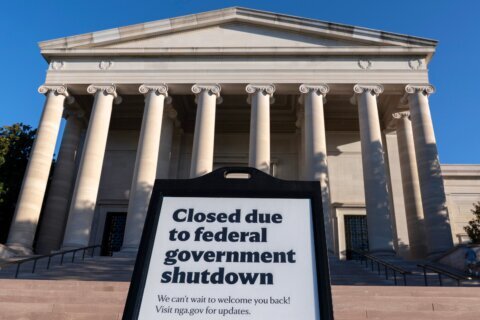D.C. and its Virginia and Maryland suburbs are dependent on the Potomac River as the main — or sole — source of drinking water.
Efforts to identify a backup water supply have taken a key step forward.
D.C. Delegate Eleanor Holmes Norton said the final version of the Water Resources Development Act of 2022, or WRDA, would authorize the U.S. Army Corps of Engineers to conduct studies to find a secondary drinking water source and additional drinking water storage.
“There is an urgent need for Congress to act to protect the drinking water and other infrastructure of the nation’s capital from serious vulnerabilities,” said Norton in a news release.
Michael Nardolilli, executive director of the Interstate Commission on the Potomac River Basin, told WTOP the water supply is vulnerable: “We do run the risk of the Potomac River becoming unavailable due to, say, an extreme drought caused by climate change, or a contamination event that could be either accidental or intentional.”
Earlier this year, the House approved a bill that would authorize an engineering and feasibility study to consider backup water supplies, but the study was not included in the Senate’s WRDA.
Since then, staff has been working behind the scenes, to include the study for both chambers.
“That will go before the House and Senate, we think, in the next two weeks for approval, and then to the president for his signature,” he said.
As with all major government projects, funding would be required to pay for the study. Ultimately, funding the suggestions of the study would be a major financial undertaking.
“So, we’re talking about a very long journey, but every journey begins with a single step, and this is the first step,” Nardolilli said.
‘Everything is on the table’ for backup supply
The study would not dictate how local water utilities should bolster their supplies.
The Potomac River is the sole water supply for the District, Arlington County and the City of Falls Church, and the primary water supply for two other local water utilities.
WSSC Water, which serves most of Montgomery and Prince George’s counties, draws 30% of the water it sends to customers from the Patuxent River. Fairfax Water, which serves Fairfax and Prince William counties, gets a portion of its water from the Occoquan Reservoir.
“Everything is on the table,” said Nardolilli. “A lot of things have been suggested: a pipeline down the Potomac from Harpers Ferry, tapping the aquifers under the city, some ‘toilet-to-tap’ program where water from the Blue Plains treatment plan could be retreated and used,” as drinking water.
As WTOP first reported in 2016, local water officials have been studying the possibility of utilizing the Travilah Quarry — which is located on Piney Meetinghouse Road in Rockville, Maryland — to provide water storage for local D.C., Maryland and Virginia water utilities, in the event that water from the Potomac River would become unavailable or undrinkable.
Nardolilli says local water suppliers have secured and are turning other quarries along the river into reservoirs.
However, he said the need to store water that is safe to drink will likely intensify. “We look at the demand increasing in the D.C. area over time. And if we are to make our system resilient, we need to have an additional backup system for what we already have.”








